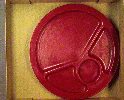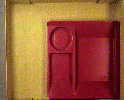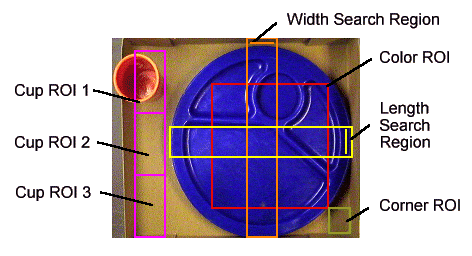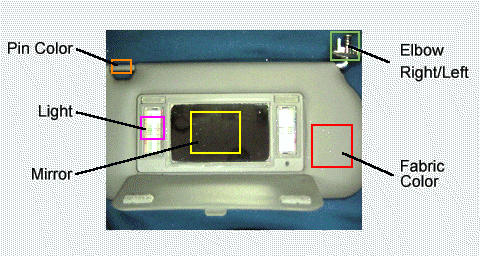|
Sometimes it is necessary to classify, verify or sort an object based on such attributes as color, shape, size
and location of its components.

 To illustrate some of the ways WAY-2C can be used to automate this type of operation, we
configured a system to inspect and label a tray containing a plate and possibly a cup. The plate,
placed in the lower right corner of the tray, can be red, yellow, blue or white and either round or
rectangular. The cup, which if present is orange, is to be placed somewhere along the left side of
the tray. Typical images from the inspection camera are shown to the left and below.
To illustrate some of the ways WAY-2C can be used to automate this type of operation, we
configured a system to inspect and label a tray containing a plate and possibly a cup. The plate,
placed in the lower right corner of the tray, can be red, yellow, blue or white and either round or
rectangular. The cup, which if present is orange, is to be placed somewhere along the left side of
the tray. Typical images from the inspection camera are shown to the left and below.
Those experienced in color machine vision will recognize that the lighting is far from ideal
and the complex color distributions would make training difficult if not impossible for
conventional color machine vision systems.
The specific objectives of the exercise were to:

- Identify the color, corner shape, length and width of the plate;
- Decide whether the orange cup is present on the left side of the tray, and if so
its approximate position;
- Print a label describing the plate and the cup position.
The inspection locations are outlined in the image to the right.
Plate color selection is based on the Color ROI.
Plate length and width are measured using their respective Search Regions using ROI's oriented in the direction of the colored lines near the ends of the region.
Shape (rectangular or round) is determined by the Corner ROI color.
Cup presence and approximate position is determined from the specific Cup ROI's which are classified
as containing a cup.
 When the classifications and measurements are complete for the tray, they are passed to a separate program to generate the label. A typical label resulting from this inspection is shown at right. Obviously the same approach can be used for generating bar-codes, monitoring product flow, etc.
When the classifications and measurements are complete for the tray, they are passed to a separate program to generate the label. A typical label resulting from this inspection is shown at right. Obviously the same approach can be used for generating bar-codes, monitoring product flow, etc.
|
A similar procedure is used to identify the characteristics of this sun visor and to automatically generate the correct bar-coded  label. Such automatic generation can substantially decrease the chances of shipping a mislabeled or incorrectly assembled product. Here the objectives were to identify fabric and pin color, left or right hand side, presence or absence of mirror and lights. After verifying correct pin color to match the fabric, and which country-specific warning label has been applied to the other side, the system generates a barcoded label.
label. Such automatic generation can substantially decrease the chances of shipping a mislabeled or incorrectly assembled product. Here the objectives were to identify fabric and pin color, left or right hand side, presence or absence of mirror and lights. After verifying correct pin color to match the fabric, and which country-specific warning label has been applied to the other side, the system generates a barcoded label.
Again the inspection locations are indicated by the colored rectangles.
|
